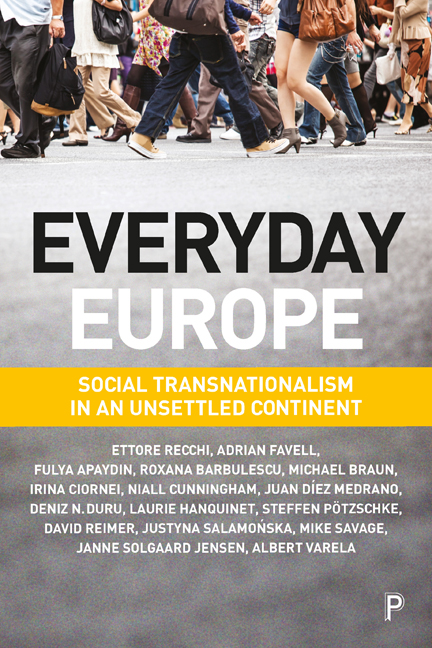Book contents
- Frontmatter
- Contents
- List of tables and figures
- Notes on contributors
- Acknowledgements
- Introduction: Social transnationalism in an unsettled continent
- one Cartographies of social transnationalism
- two The social structure of transnational practices
- three Cultural boundaries and transnational consumption patterns
- four Social transnationalism and supranational identifications
- five Explaining supranational solidarity
- six Narratives and varieties of everyday transnationalism
- seven Understanding Romanians’ cross-border mobility in Europe: movers, stayers and returnees
- eight Transnational Turkey: the everyday transnationalism and diversity of Turkish populations in Europe
- Epilogue Is social transnationalism fusing European societies into one?
- Methodological appendix
- Index
Methodological appendix
Published online by Cambridge University Press: 19 April 2022
- Frontmatter
- Contents
- List of tables and figures
- Notes on contributors
- Acknowledgements
- Introduction: Social transnationalism in an unsettled continent
- one Cartographies of social transnationalism
- two The social structure of transnational practices
- three Cultural boundaries and transnational consumption patterns
- four Social transnationalism and supranational identifications
- five Explaining supranational solidarity
- six Narratives and varieties of everyday transnationalism
- seven Understanding Romanians’ cross-border mobility in Europe: movers, stayers and returnees
- eight Transnational Turkey: the everyday transnationalism and diversity of Turkish populations in Europe
- Epilogue Is social transnationalism fusing European societies into one?
- Methodological appendix
- Index
Summary
EUCROSS was designed as a mixed-methods research project consisting of a representative survey and qualitative interviews. Computer-assisted telephone interviews (CATI) were conducted in Denmark, Germany, Italy, Spain, Romania and the United Kingdom. The target populations consisted of: (a) 1,000 ‘nationals’ of the country (defined below), and (b) 250 Romanian and 250 Turkish foreign residents in the country, whom we consider ‘migrants’ (also defined below). However, due to the low number of Turkish foreign residents in Spain, only Romanians were included in the survey there. Hence, the envisioned total sample sizes were 6,000 EU member state nationals currently living in their country of origin, 1250 intra-EU migrants (Romanian citizens) and 1250 migrants from a third non-EU country (Turkish citizens).
For the qualitative part of the project (EUMEAN), semi-structured qualitative interviews were conducted with 10 selected participants per country from each sample of the survey (nationals, Romanian and Turkish migrants).
The EUCROSS survey
Definition of the sample
The goal of the EUCROSS project was to collect data on transnational behaviours and orientations of different groups of EU country residents. To be included in one of the three abovementioned broadly defined samples (nationals, Romanian migrants, Turkish migrants) respondents had to be at least 18 years old at the time of the interview.
Taking into consideration the empirical reality of European countries, our definition of the ‘national’ samples is not based on any assumption of ethnic homogeneity. Hence, the essential criterion for inclusion in one of the six national samples was citizenship in its strictly legal sense. In using this formal aspect as a sampling criterion, EUCROSS sets itself apart from other approaches which might limit the definition of the reference national population to those who have been born there (that is, in the country of residence [CoR]), or even to those whose families have lived there for a given number of generations (excluding individuals with a migration background, defined by a family origin traceable within that range of generations to a different country [CoO]). A consequence of the provisions made in EUCROSS is that naturalised ‘immigrants’ (including, for example, persons originally from Romania or Turkey) may also be part of the national population samples.
- Type
- Chapter
- Information
- Everyday EuropeSocial Transnationalism in an Unsettled Continent, pp. 291 - 300Publisher: Bristol University PressPrint publication year: 2019



